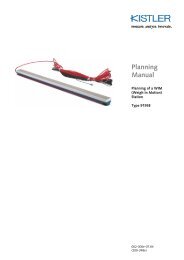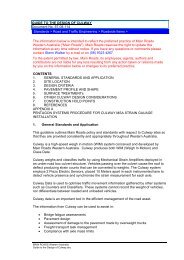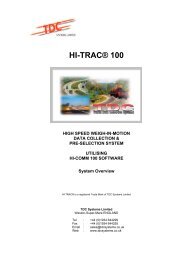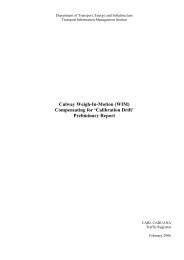AP-G84/04 Best practice in road use data collection, analysis ... - WIM
AP-G84/04 Best practice in road use data collection, analysis ... - WIM
AP-G84/04 Best practice in road use data collection, analysis ... - WIM
You also want an ePaper? Increase the reach of your titles
YUMPU automatically turns print PDFs into web optimized ePapers that Google loves.
Accessed by AR - ARRB TRANSPORT RESEARCH on <strong>04</strong> Feb 2005<br />
3 VEHICLE DETECTION AND CLASSIFICATION<br />
Aust<strong>road</strong>s 20<strong>04</strong><br />
— 3 —<br />
<strong>Best</strong> Practices <strong>in</strong> Road Use Data Collection, Analysis and Report<strong>in</strong>g<br />
The Aust<strong>road</strong>s (1988a and 20<strong>04</strong>) Guide to Traffic Eng<strong>in</strong>eer<strong>in</strong>g Practice (GTEP) Part 3 on Traffic<br />
Studies provides a b<strong>road</strong> background to vehicle detection and classification and other traffic<br />
studies. Discussions on technologies such as image process<strong>in</strong>g and Global Position<strong>in</strong>g System<br />
(GPS) will only be mentioned <strong>in</strong> pass<strong>in</strong>g <strong>in</strong> this report. The focus of this section is on gett<strong>in</strong>g the<br />
most out of currently <strong>use</strong>d technologies, which are axle and <strong>in</strong>ductive loop sensors.<br />
3.1 Axle Sensor and Axle Counts<br />
The most common type of axle sensor is the pneumatic tube with an air switch. It is suitable <strong>in</strong><br />
both urban and rural environments for temporary axle counts. Two tubes are usually needed for<br />
speed measurement and vehicle classification. A two-tube <strong>in</strong>stallation for vehicle classification on a<br />
local <strong>road</strong> is shown <strong>in</strong> Figure 1. The photograph shows the set-up for the monitor<strong>in</strong>g of two lanes of<br />
vehicular traffic and a bicycle path on the near side of the photograph.<br />
Figure 1 – A pair of pneumatic tubes and a vehicle classifier on a local <strong>road</strong> monitor<strong>in</strong>g<br />
two lanes of vehicle traffic and a bicycle path on the nearside of the photograph<br />
A s<strong>in</strong>gle axle sensor has been found <strong>use</strong>ful <strong>in</strong> a wide range of <strong>road</strong> traffic conditions. For s<strong>in</strong>gle<br />
lane traffic, one axle sensor usually presents no problems <strong>in</strong> obta<strong>in</strong><strong>in</strong>g axle counts. At remote sites,<br />
s<strong>in</strong>gle axle sensors are sometimes <strong>use</strong>d <strong>in</strong> permanent count stations beca<strong>use</strong> they are reasonably<br />
reliable and repair costs at remote sites are expensive. For multi-lane traffic (<strong>in</strong> one or two<br />
directions), axle counts are missed when the wheels of two different vehicles arrive at an axle<br />
sensor at the same time. Install<strong>in</strong>g two axle sensors could improve accuracy but the <strong>in</strong>stallation of<br />
two axle sensors also <strong>in</strong>crease the Occupational Health and Safety (OH&S) risk.

















